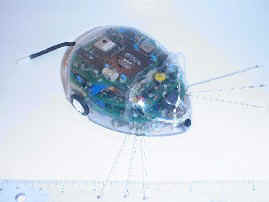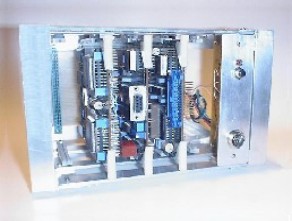Maelzel
Rodent Model (P-Type Agency)

The technology shown is based on instantiations of Alan Turing's P-Type unorganized machines. He described these machines in a 1948 essay in which he called for their further study.
The photographs shown are those of an artificial lab rodent whose controller agency was a P-Type machine. The experiment was run in both HW & SW.
The embodied and situated machines were stimulus/response (S/R) learners that demonstrated learned sequences of behavior over generalized stimuli. In the experiment, the artificial rodents had to demonstrate a degree of adaptive fitness through the assimilation of both self-taught and teacher-taught sensorimotor behaviors.

Adapted from Turing's algorithm, the rodent agency initially accommodated unknown stimuli using previously learned S/R knowledge (if it was available). Then, when they encountered new stimuli, the would select new (hopefully more fit), adaptive behavior sequences from a library of simple taxis/kinesis tokens assimilating those that were successful into S/R knowledge.
The selection (or learning) of new behavior was steered by a cybernetic process that differentiated pleasure and pain stimuli relevant to the agent-host pair in its own environment. The results of the research suggest that Turing's Engine of Intelligence could easily be adapted for use in controlling other host vehicles or platforms, i.e., not just mice.
Ultimately, the series of experiments were described under a single theoretic heading. The name that was selected was, "Cybernetic Intelligence: A Return to Complex Qualitative Feedback Theory."
More detailed information on the Rodent Model can be obtained here.